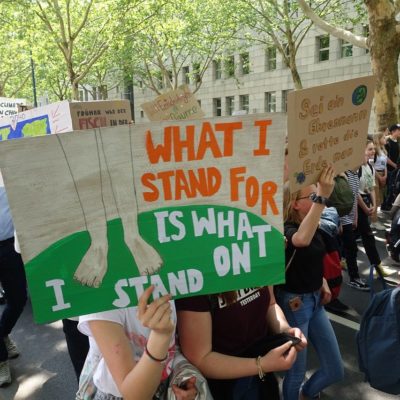International Women’s Day, celebrated on March 8 every year since 1911, is a global day celebrating the social, economic, cultural and political achievements of women. This day is not country, group or organization specific. As Gloria Steinem (feminist, journalist, activist) once explained: “The story of women’s struggle for equality belongs to no single feminist nor to any one organization but to the collective efforts of all who care about human rights.”
Women’s Day is the day when we should all recharge our commitment to gender equality. This day is all about unity, celebration, reflection, advocacy and action. In this reflection, I want to celebrate all women and especially the amazing strength of women who have stepped up as individuals, as part of communities and made their voices heard. Reminding us that our individual actions, conversations, behaviour and mind-set have an impact on our entire society.
Reflecting on 2019, women and allies of all genders have been leading the charge for social and political change. From the streets of India and Iraq to Lebanon and South Africa, women have been at the forefront of protest movements against crippling gender and economic inequality, corruption and inept government, braving rubber bullets and live fire, arrest and even death.
Last year has also been a year of amplifying alliances between feminist and LGBTQ communities, from legal battles over transgender rights and same-sex marriage in Kenya and India to movements pushing for more inclusive, gender-neutral language in places such as Germany and Argentina.
It has been a year of loss and pain, too: the countless women hurt or killed by their husbands, brothers and acquaintances; the tragedies of gender-based violence that are estimated to affects 1 in 3 women in their lifetime worldwide. Stories of few briefly generate international headlines before all too often fading from public memory.
Let’s take a look back at some of the key events, wins, losses and patriarchy-smashing moments for women’s rights and gender equality in what has been a roller coaster ride of a year.

In January 2019, in one of the biggest moments for women’s rights in India, around 5 million women formed a 385 mile long ‘women’s wall’ in protest of gender equality. This was one of the largest ever congregations of women in the world – young and old, rural and urban, farmers and academics, activists and actors – standing shoulder-to-shoulder along the highways and together taking the pledge to fight for gender equality.
Women in South Africa came together to demonstrate against the scourge of femicide in South Africa. The demonstration came after a series of violent attacks against women and the release of official crime statistics showing a countrywide murder rate of 58 a day, a 3.4 percent increase in a year. The South African government has declared gender-based violence a national crisis. The women called on government and the private sector to provide funds to fight the scourge. The action plan President Cyril Ramaphosa presented includes setting up a $68 million fund, beefing up the criminal justice system, improving the legal and policy framework around sexual offenses and other forms of gender-based violence, and empowering women economically.

In Sudan, months of protests culminated in the April ousting of Omar Hassan al-Bashir , whose nearly 30-year rule was marked by conflict, oppression and economic struggles.
Women in conservative Sudan were at the forefront of the demonstrations. One protester, 22-year-old Alaa Salah, became a symbol of the revolution after an iconic photo was taken during the widespread protests just days before the President of Sudan was arrested. Women and youth were the driving force of the movement in Sudan, representing more than 70 per cent of the protestors. In October 2019, Salah addressed the UN Security Council, calling on the international community to ensure women’s meaningful participation in the transition process going forward.
In Iraq, women have joined the frontline of protests, tended to the wounded, organized protest camps, fed protesters and faced off with security forces, helping to sustain two months of demonstrations challenging the often-corrupt sectarian political system set up after the war. Murals have spread across Baghdad, depicting the spirit of the women at the centre of this protest.
In Lebanon, where the public has been protesting for weeks against sectarianism and corruption, women have been a key driving force behind the movement. In a political system where women are chronically underrepresented, women are at the front line of marches and discussion groups. But the biggest impact women have had on the protests is making them more peaceful. The first two nights of demonstrations were marked by violent clashes between police and protesters that continued deep into the night. But on the third evening, a group of women decided to form a human shield to separate the two sides. They called it the women’s front line. The reduction in violence that followed this direct action meant that more people felt comfortable enough to join the protests, which have been the largest in more than a decade.
All over the world, young women like Greta Thunberg and Isra Hirsi are making headlines for leading the global protests against climate change. But it’s important to remember that women have always been at the forefront of climate justice, because they are disproportionately affected by environmental issues. Millions of women have joined the protest in 2019 to demand urgent action to tackle the climate crises.
Finally, the #MeToo movement has been thriving, and what exploded as a tidal wave on social media has translated into robust public debate, shifting social norms, and concrete changes in laws and policies. One of the biggest changes is the growing space and support for survivors to speak up and break the silence around sexual harassment and assault. In a landmark development that could change sexual harassment laws and practice globally, governments, employers, and worker representatives in June adopted the Violence and Harassment Convention, setting out minimum obligations for how governments should address harassment and violence at work.
While all these examples show that women are increasingly at the centre of social and political movement, there is still a long way to go to achieve gender parity.
‘A wake up call to the world’: No one country is on track to reach gender equality by 2030
In 2015, United Nations Member States have set and agreed on 17 Sustainable Development Goals (SDGs). Women’s equality and empowerment is a separate SDGs, as well as being integral to all dimensions of inclusive and sustainable development – and therefore crucial to attaining most of the other SDGs. Despite this, gender equality is one of the most underfunded of the SDGs. According to the first index developed to measure progress against a set of internationally agreed targets, no country in the world is on track to achieve gender equality by 2030. Four out of five women (2.8 billion women and girls worldwide) live in countries rated ‘poor’ or ‘very poor’ for gender equality.
As stated by UNFPA Goodwill Ambassador Ashley Judd:
“Women and girls count. We matter. Our rights are inherent to us. If we invest in girls and women, the world and all of the 17 Sustainable Development Goals will advance forward rapidly as a result.”
International Women’s Day is a day of taking stock and a day of celebrating achievements. But most importantly, it is a day to remind all of us that the struggle for gender parity and equality is far from over. Each of us can take action and start conversation to change behaviours and mindsets, rolling the ball for people, communities, world leaders, development institutions and environmental organisations to join together in call for the empowerment of women and girls as a priority path towards a happier, more sustainable world.
Image source: Photo by Dulcey Lima on Unsplash.



